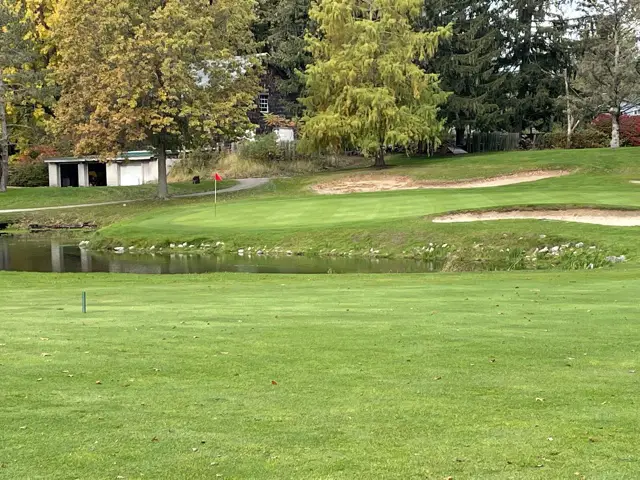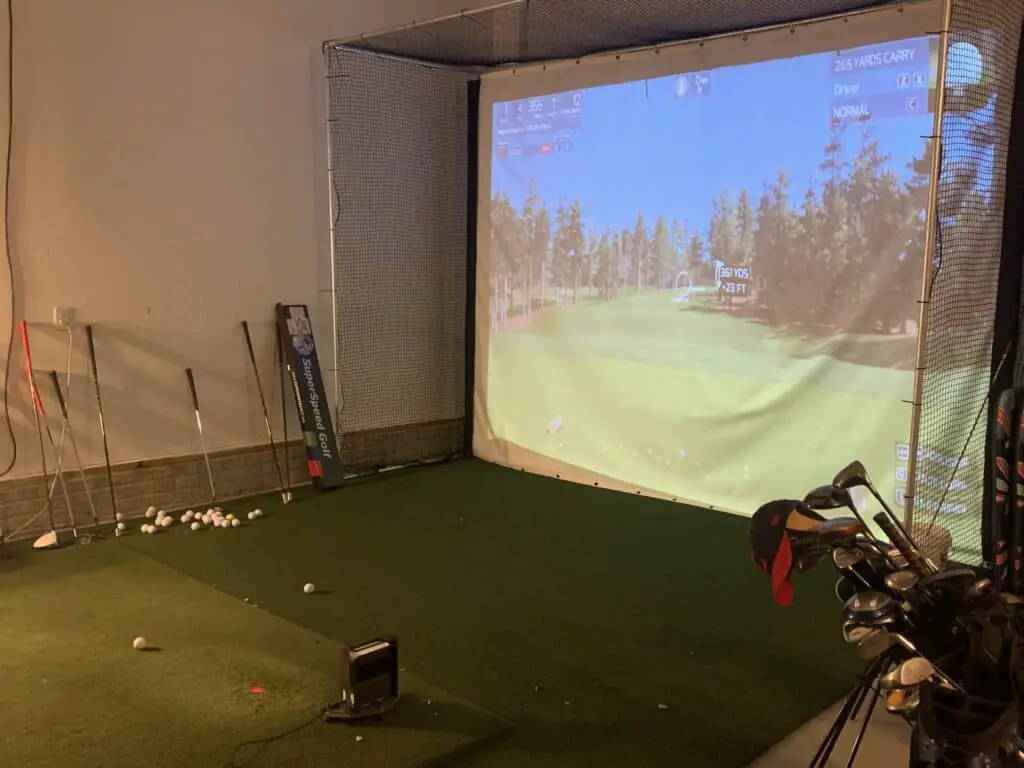The world of golf can be confusing, especially when it comes to wedges.
Most people know that a driver is between 9 and 11 degrees in loft, but what about wedges?
Many people struggle to find the right combination, but it doesn’t have to be complicated. Below we will dive into what degrees are the various golf wedges and make a recommendation for what you should have in your golf bag.
Also, we are big believers in testing out your wedges and using the technology in today’s game to properly map your bag and ensure you have the right equipment for your swing and your game!
What Degrees Are Golf Wedges?
Wedges range between 48 and 64 degrees. More specifically, the pitching wedge is 48 degrees, the gap wedge is 52 degrees, the sand wedge is 56 degrees, and the lob wedge is 60 or 64 degrees. This leaves the golfer plenty of options to ensure they have the right lofted wedges in their bag.
Below is a quick reference chart to what degree the golf wedges are:
| Wedge | Loft | Approximate Distance |
| Pitching Wedge | 48 | 100-140 yards |
| Gap Wedge | 52 | 80-120 yards |
| Sand Wedge | 56 | 60-110 yards |
| Lob Wedge | 60-64 | 40-100 yards |

What Degree Should A Pitching Wedge Be?
The pitching wedge is typically 48 degrees in loft and will carry between 100-140 yards depending on your swing speed and quality of contact. The pitching wedge is the club between the 9 iron and your gap wedge and is an essential club for scoring.
The pitching wedge is typically the one wedge included in your set if you buy a complete set of irons. It will be the same make and model as the rest of your irons.
The pitching wedge is a versatile club that will be used for full shots and can be used around the green for a flatter chip shot that has some run to it when compared to a chip shot with a sand wedge or lob wedge.
Lob wedge vs pitching wedge: Differences?
What Degree Should A Gap Wedge Be?
The gap wedge is typically between 50 and 54 degrees, with the most common degrees at 52 degrees. It is called a gap wedge because it closes the 8 degree gap between pitching wedge and sand wedge.
Unless you are really good at 3 quarter or half shots, a gap wedge is an essential club in your bag. Keep in mind that 60% of shots in golf take place from 100 yards and in.
The gap wedge will not come with your set and is typically bought in combination with your sand wedge and lob wedge. The key is to find the right yardages between your 4 wedges (pitching, gap, sand and lob).
It will be used for a full swing and possibly when chipping. If you are someone that prefers to use various clubs when chipping to change the height and roll out on a chip shot, then you will find the gap wedge to be in your hands often around the green.
What degree wedge is best for chipping?
What Degree Should A Sand Wedge Be?
The sand wedge is most commonly a 56 degree club. However, some will carry a sand wedge between 54 and 56 degrees. If a golfer does not carry a gap wedge, they may prefer to have a 54 degree sand wedge to build a set of wedges at 48, 54 nd 60.
This has a 6 degree difference between wedges, while the rest of your irons have around 4 degree difference between clubs.
By carrying only 3 wedges, instead of 4, the golfer is able to carry an extra iron, hybrid or fairway wood providing greater flexibility in the longer clubs for the golfer that needs the extra club.
If you are good at hitting less than full shots, you might be able to only carry 3 wedges. I personally carry a 48, 54 and 60 and can hit all of the shots I need from the various distance inside of 125 yards.
What Degree Should A Lob Wedge Be?
The lob wedge is most commonly a 60 degree club. However, some will carry a 64 degree lob wedge for a difficult course with really firm greens and major drop offs around the greens.
For many golfers, a 60 degree wedge is enough loft to hit a flop shot around the green and be successful.
In really difficult course conditions, the 64 degree wedge might be helpful. However, the golfer has to eliminate a club elsewhere as they have their limit of 14 total clubs.
The lob wedge can be used for full shots and with just about every chip or pitch shot required on a course. For many, they only chip or pitch with their lob wedge and try to master the various shots they might need.
A golfer like Phil Mickelson pretty much only uses his lob wedge when chipping and pitching!
Also, the lob wedge is really important for greenside bunkers. With the amount of undulation and deep bunkers on the most difficult courses, the lob wedge is really important out of the sand.
I hit my lob wedge on just about every sand shot from a greenside bunker, unless there is a 30 yard bunker shot and the front lip is flatter, then I will use my 54 degree wedge.

Map Your Bag and Control Your Wedges
Distance control is vital with the wedges.
You need to know your numbers when hitting a 100%, 90% and 80% swing with each wedge in your bag. Keeping these numbers and knowing your numbers when you head out onto the course is vital to your success!
I would highly recommend each golfer create a distance chart like the sample below:
| Club | Carry Distance (100%) | 90% | 80% |
| 2 Utility Iron | 210 | ||
| 4 iron | 190 | ||
| 5 iron | 181 | ||
| 6 iron | 171 | ||
| 7 iron | 163 | ||
| 8 iron | 153 | ||
| 9 iron | 143 | ||
| P Club | 130 | 123 | 115 |
| Pitching Wedge | 118 | 110 | 102 |
| SW Club | 105 | 97 | 91 |
| LW Club | 90 | 82 | 74 |
This might be the most important information you can use to help you play quality golf. I have heard so many stories and have seen it first hand where golfers completely over estimate how far they hit each iron or wedge.
They hit one sand wedge 105 yards one time and think this is their carry distance. So they step up to a 105 yard shot, hit the sand wedge and end up in a bunker. They blade it out of the bunker and are looking at a double bogey as their reality. Instead, if they had the right club and hit the gap wedge or pitching wedge, their chance of hitting the middle of the green would increase greatly!
How can you create your own distance chart in golf?
Option 1: I would highly recommend a launch monitor!
These portable devices can be used at the driving range, golf course or set up in your home net or golf simulator. These devices are game changers not only on being able to map your bag and know your distances, but they also provide quality feedback after on every shot and provide the following information:
- Carry Distance
- Spin Rate
- Launch Angle
- Spin Axis
- Total Distance
- Ball Speed
This information will help you map your bag, decide on which clubs are best for your game, develop a stock shot and much more. I love using my SkyTrak 365 days a year in my golf simulator setup.
The process for mapping your bag can looking something like this:
- Hit 5 shots with each club in your bag.
- Log the carry distance and total distance for each shot.
- Eliminate any outlier numbers (poor hits or low spin rates).
- Take the average and create a map of your bag.
If you visit any PGA Tour event you will see plenty of golfers utilizing their launch monitors. While most can’t afford a Trackman, there are some very affordable options in the 500-2000 dollar range. I own the SkyTrak and think the world of it.
Here are the top 3 options to check out:
Option 2: Use a Driving Range or Open Field
If you can’t afford a launch monitor at this time, here is another option.
- Find an open driving range or open field
- Take 10 balls of the type of golf ball you play
- Pick a target and either walk it off or use a rangefinder.
- Hit 10 shots with each club in your bag and take an average.
- Your rangefinder can help you get a specific distance.
Go ahead and create a chart of each club and their carry distance like the one above.

My Secret To Golf Improvement
Let’s face it, in order to get really good at golf, we must practice frequently. About three years ago, I made the leap and invested in a golf simulator build for my garage. I went with a SkyTrak Launch Monitor and the TGC software and can now play over 100,000 courses including Augusta, Pebble Beach, Bethpage Black, Whistling Straits. St. Andrews and many other of the top 100 courses in the world.
This golf simulator setup, which is more affordable that you might imagine, has been a game changer. I can now play golf everyday of the year regardless of rain, snow, cold weather or time of day. I can practice or play rounds of golf. I can stand in the 11th fairway at Augusta and with the auto-rewind feature I am able to practice my approach shots from various differences.
It is worth checking out through Rain or Shine Golf as they offer some incredible packages along with financing offers that are difficult to beat.
Some direct links to Rain or Shine Golf for pricing and financing:
Take Action – What You Can Do Today to Get Better
What does this mean for you? I believe in the following recipe to get better:
1 – Improve your motion in the golf swing by identifying a golf instructor. Here are some options:
Here is a list of golf instructors that we have reviewed:
2 – Train to swing faster and improve your swing speed. Here are some options:
Looking to gain more Speed and Distance in your swing. Two Options:
3 – Understand course strategy and work to break through your next barrier. Here is a series on breaking through:
We have provided guides on how to break 100, 90, 80 and 70. Check out more below, if interested.
4 – Practice Frequently
Did you know that I build a golf simulator in my garage and have played over 500 rounds of golf on my SkyTrak system? It has been a game changer and one worth checking out. Here are some of my other posts on golf simulatorsfrequently asked questions:
- Is a Golf Simulator Worth It?
- How to Build a Golf Simulator?
- What is the Best Golf Simulator?
- Golf Simulator Accessories?
- How to Build a Golf Simulator for under $7000
- Top 11 Reasons to Buy a SkyTrak
- How to Build a Golf Simulator for Under $1000
- Why Build A Golf Simulator?
- What Space is Needed?
- Can A Golf Simulator Improve My Game?
- How Much Does A Golf Simulator Cost?
- Don’t Forget to Check out our 15 best golf swings of all time.
